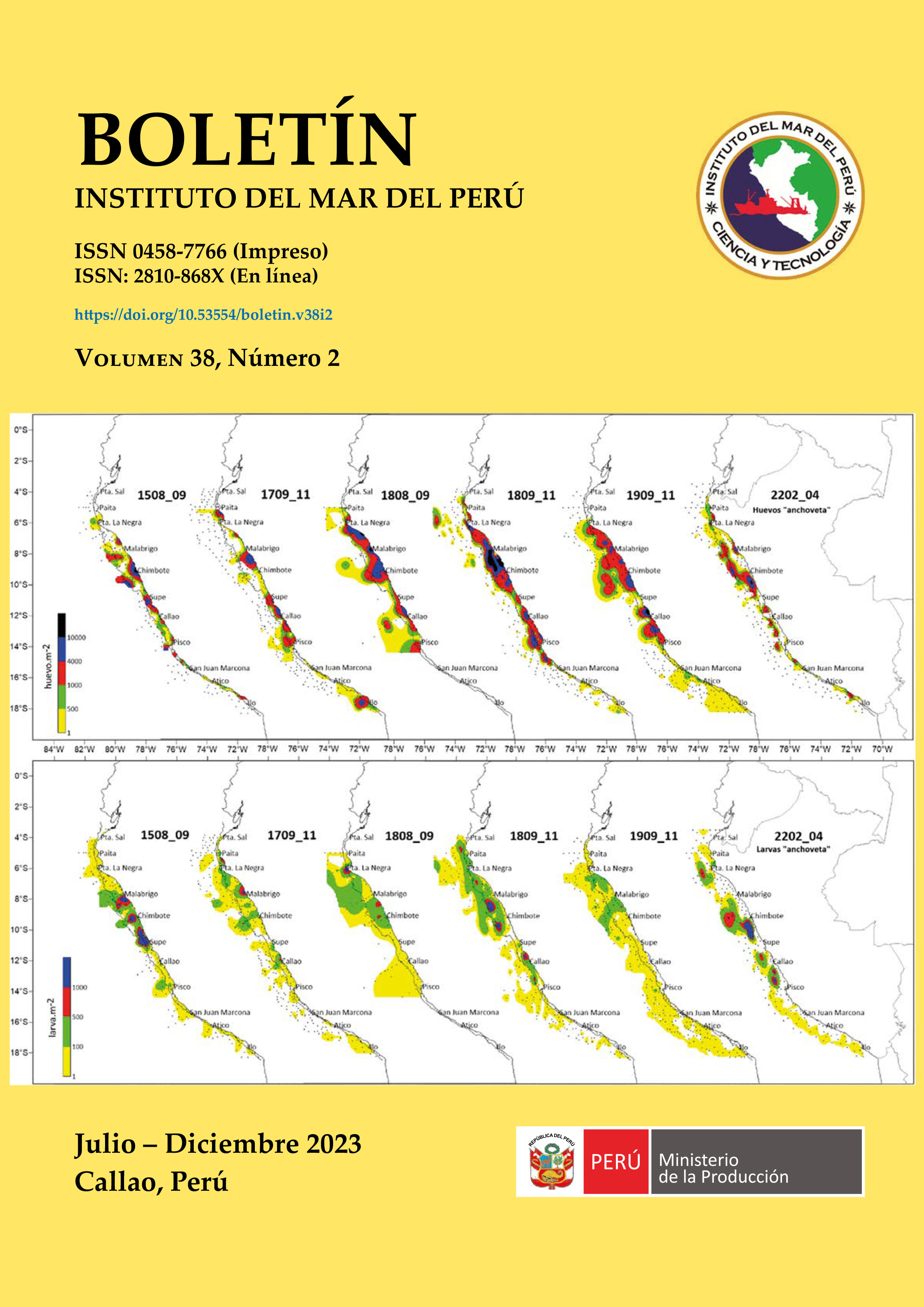Zooplankton biovolumes, abundance and distribution of ichthyoplankton, euphausiids, and cephalopod paralarvae (summer 2022)
DOI:
https://doi.org/10.53554/boletin.v38i2.393Keywords:
Biovolumes, Ichthyoplankton, Euphausiids, Paralarvae, Engraulis ringensAbstract
Zooplankton biovolumes ranged from 6.02x10-4 and 7.23 mL.m-3, averaging 0.53 mL.m-3 with a median of 0.22 mL.m-3 during the summer of 2022. The lower biovolumes (0.01-0.2 mL.m-3) were more prevalent, accounting for 49.5 % of the samples, and were primarily concentrated along the coastal zone. Values exceeding 1 mL.m-3 were scattered outside the continental shelf, notably off Punta Sal-Talara, Punta La Negra, Huarmey-Huacho, Callao, San Juan de Marcona, and Atico. Engraulis ringens was the most frequently observed ichthyoplankton species, comprising 51.96 % of the samples for eggs and 41.67 % for larvae. Ichthyoplankton densities varied from 4,000 to 10,000 eggs.m-2, predominantly in the coastal area between Chimbote and Huarmey. Densities surpassing 1,000 larvae.m-2 were observed between Malabrigo and Huarmey. Larvae were predominantly found in the size range of 3 to 3.5 mm (2,472 larvae.m-2). The prevalent euphausiid species was Euphausia mucronata, with adults (34.8 %) and juveniles (29.9 %) distributed both within and beyond the continental shelf, spanning from Paita (north) to Ilo (south). Furcilia (45.59 %) and calyptopis stages (36.27 %) of “undetermined” species were common in the overall count, with a higher concentration within the shelf from north of Talara to the south of Punta La Negra and a more dispersed presence beyond the shelf in the central-southern zone, from Malabrigo to the south of Ilo. Concerning cephalopod paralarvae, Argonauta spp. were the most frequently encountered species (11.27 %), with a median count of 3 ind.m-2.
Downloads
Alternative Metrics
Metrics
References
Arones, K., Quesquén, R., Nakasaki, C. & Ayón, P. (2022). Spatial-temporal variability of Euphausiids in the Northern Humboldt Current System between 2013 and 2020. In: EBUS Conference. Lima, Perú. https://www.ebus-lima2022.com/es/program/bookof-abstracts
Ayón, P., Criales-Hernandez, M. I., Schwamborn, R. & Hirche, H.-J. (2008a). Zooplankton research off Peru: A review. Progress in Oceanography, 79(2), 238-255. https://doi.org/10.1016/j.pocean.2008.10.020
Ayón, P., Swartzman, G., Bertrand, A., Gutiérrez M. & Bertrand, S. (2008b). Zooplankton and forage fish species off Peru: Large-scale bottom-up forcing and local-scale depletion. Progress in Oceanography, 79(2), 208–214. https://10.1016/j.pocean.2008.10.023
Boden, B. P., Johnson, M. W. & Brinton, E. (1955). The Euphausiacea (Crustacea) of the north Pacific. Bulletin of the Scripps Institution of Oceanography of the University of California, La Jolla, 6(8), 282-394. https://escholarship.org/uc/item/62h3k734
Brinton, E. (1962). The distribution of Pacific Euphausiids. Bulletin of the Scripps Institution of Oceanography of the University of California, 8(2), 51-270. https://escholarship.org/uc/item/6db5n157
Kramer, D., Kalin, M. J., Stevens, E. G., Thrailkill, J. R. & Zweifel, J. R. (1972). Collecting and processing data on fish eggs and larvae in the California Current Region. NOAA Technical Report NMFS, Circ-370. U. S. Department of Commerce. NOAA. National Marine Fisheries Service. https://spo.nmfs.noaa.gov/sites/default/files/legacy-pdfs/CIRC370.pdf
Moser, H. (1996). The early stages of fishes in the California Current Region. California Cooperative Ocean Fisheries Investigations, 73(3), Atlas Nro. 33, 1505.
Einarsson, H. & Rojas de Mendiola, B. (1963). Descripción de huevos y larvas de anchoveta (Engraulis ringens J.). Bol. Ins. Recurs. Mar., Callao, I(1),1-23. https://hdl.handle.net/20.500.12958/64
ENFEN. (2022). Estado del sistema de alerta: Alerta de La Niña Costera (COMUNICADO OFICIAL ENFEN N°02-2022). https://www.dhn.mil.pe/Archivos/oceanografia/enfen/comunicado-oficial/02-2022.pdf
ENFEN. (2018). Estado de sistema de alerta: Alerta de La Niña Costera (COMUNICADO OFICIAL ENFEN N° 02-2018). http://hdl.handle.net/20.500.12816/2388
Orosco, X. (2016). Variabilidad espacio-temporal de paralarvas de cefalópodos en el mar peruano entre los años 2013 y 2014. [Tesis de pregrado]. Universidad Ricardo Palma.
Orosco, X. (2022). Annual variability (2013-2022) of the distribution and abundance of cephalopod paralarvae in the NHCS (Presentación Oral). In EBUS 2022 Conferences Program. Lima – Perú (September 19-23, 2022). https://www.ebus-lima2022.com/es/program/book-of-abstracts
Orosco, X. (2023a). Biovolúmenes del zooplancton, distribución y abundancia de ictioplancton, eufáusidos y paralarvas de cefalópodos, verano 2020. Bol Inst Mar Perú, 38(2), 284-302. https://doi.org/10.53554/boletin.v38i2.392
Orosco, X. (2023b). Biovolúmenes de zooplancton, distribución y abundancia de ictioplancton, eufáusidos y paralarvas de cefalópodos en primavera 2019. Bol Inst Mar Perú, 38(2), 266-283. https://doi.org/10.53554/boletin.v38i2.391
Orosco, X. & Ayón, P. (2015). Abundancia, frecuencia y distribución de eufáusidos frente a la costa norte del Perú. Revista de Ciencias, 11, 20-30.
Perea, A., Peña, C., Oliveros-Ramos, R., Buitrón, B. & Mori, J. (2011). Producción potencial de huevos, reclutamiento y veda reproductiva de la anchoveta peruana (Engraulis ringens): Implicaciones en el manejo pesquero. Cienc. Mar., 37(4b), 585-601. https://www.scielo.org.mx/pdf/ciemar/v37n4b/v37n4ba6.pdf
Pinedo, E. (2022). Ictioplancton, eufáusidos y biovolúmenes de zooplancton, verano 2016. Inf. Inst. Mar. Perú, 49(2), 303-214. https://hdl.handle.net/20.500.12958/4768
Pinedo, E. & Ayón, P. (2023). Ictioplancton, eufáusidos y bio-volúmenes de zooplancton del mar peruano durante el verano del 2019. Inf Inst Mar Perú, 50(1), 47-59. https://hdl.handle.net/20.500.12958/7533
Quesquén, R. & Ayón, P. (2023). Composición, distribución y abundancia de eufáusidos e ictioplancton frente a la costa peruana durante el verano 2018. Inf Inst Mar Perú, 50(2), 240-247. https://hdl.handle.net/20.500.12958/7767
Roy, C., Cury, P. & Kifani, S. (1992). Pelagic fish recruitment success and reproductive strategy in upwelling areas: environmental compromises. South African Journal of Marine Science, 12(1), 135-146. https://doi.org/10.2989/02577619209504697
Santander, H. & Sandoval de Castillo, O. (1973). Estudio sobre la primera etapa de vida de la anchoveta. Inf Inst Mar Perú, 41, 30. https://hdl.handle.net/20.500.12958/269
Sweeney, M. J., Roper, C. F. E., Clyde F. E., Mangold, K. M., Clarke, M. R. & Boletzky, S. V. (Eds.). (1992). Larval and juvenile cephalopods: a manual for their identification. Smithson. Contributions to Zoology, 513, 282 pp. https://doi.org/10.5479/si.00810282.513
Van Guelpen, L., Markle, D. F. & Duggan, D. J. (1982). An evaluation of accuracy, precision and speed of several zooplankton-subsampling techniques. Journal du Conseil International pour L’exploration de la Mer, 40, 226-236. https://doi.org/10.1093/icesjms/40.3.226
Downloads
Published
How to Cite
Issue
Section
License
Copyright (c) 2023 Boletin Instituto del Mar del Perú

This work is licensed under a Creative Commons Attribution 4.0 International License.










